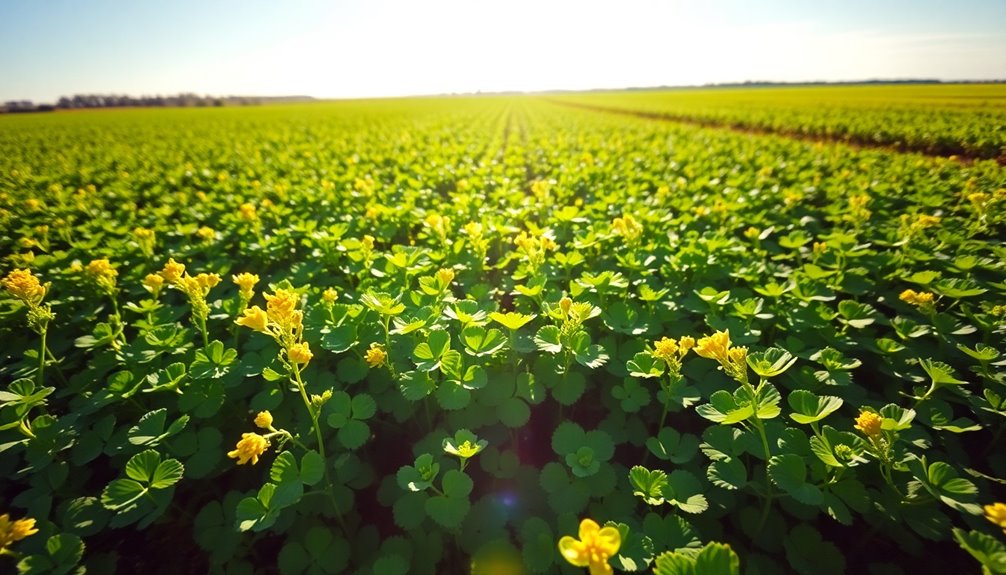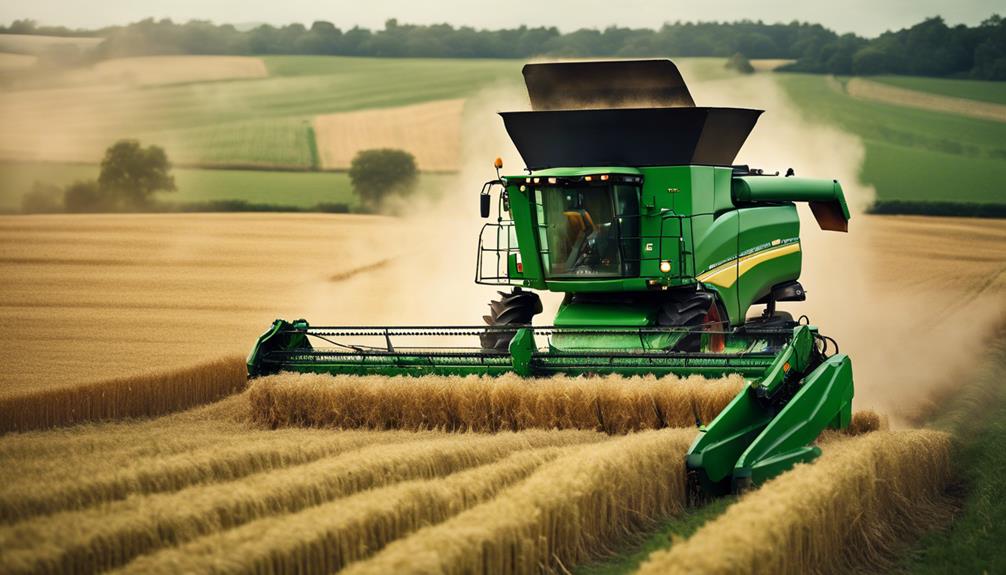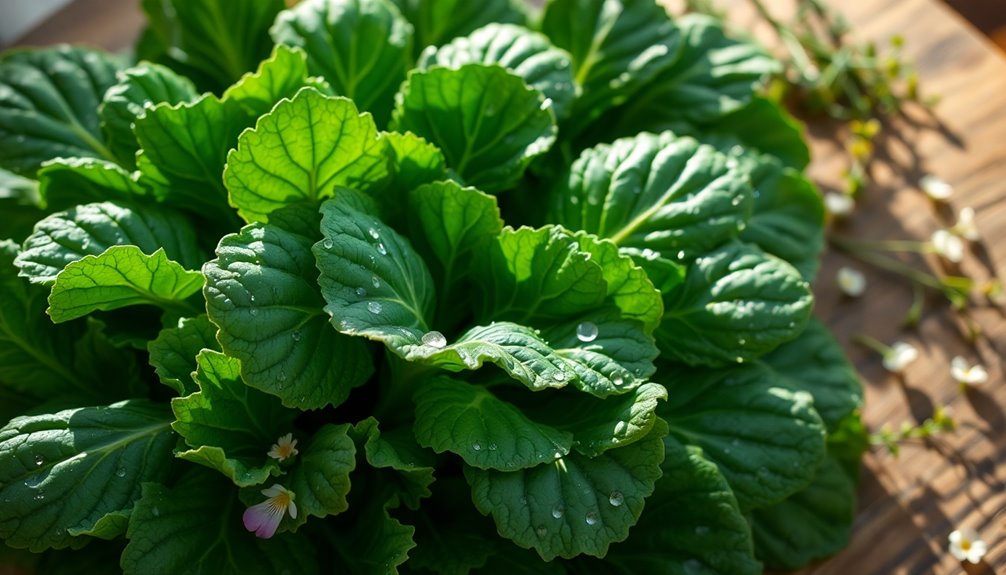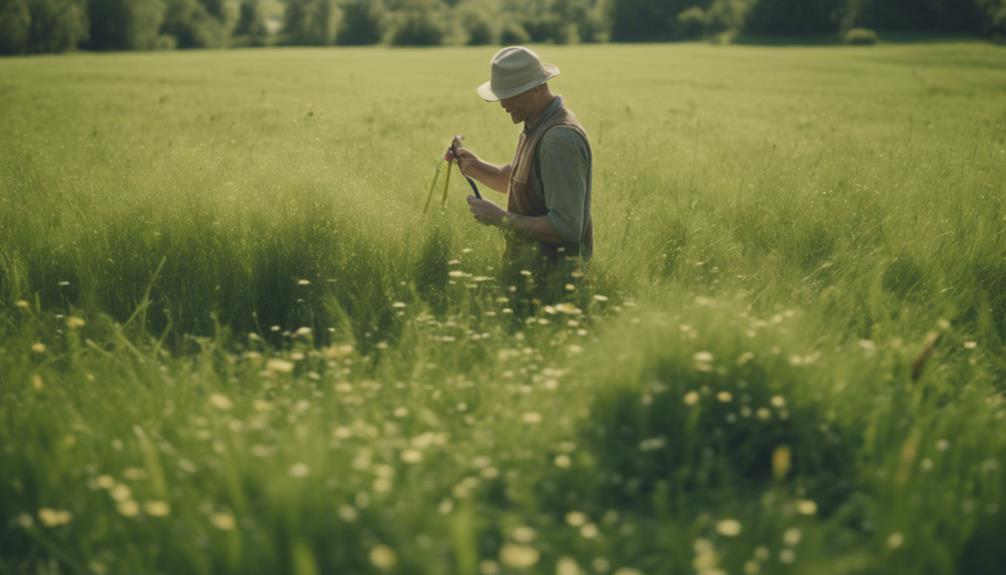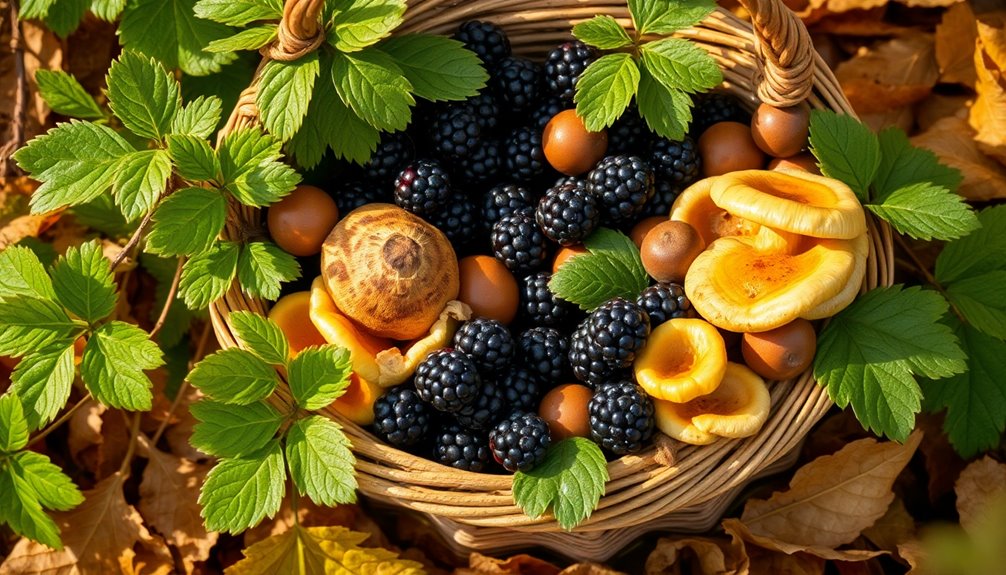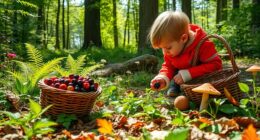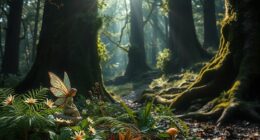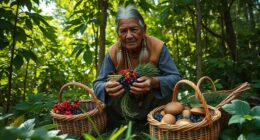In May, you're in for a treat with a host of wild edibles ripe for foraging. Look for wild garlic, which adds a punch to salads and pestos, and young beech leaves, perfect for unique sorbets. Hawthorn blossoms can sweeten your drinks, while stinging nettles offer numerous health benefits. Don't overlook marsh samphire for its salty crunch or chickweed for a fresh salad addition. As you explore, remember to forage responsibly, taking only what you need. Uncovering these hidden delights is just the beginning—there's so much more to discover about seasonal foraging!
Key Takeaways
- In May, you can forage for wild garlic, which enhances dishes with its distinct flavor and is rich in vitamins A and C.
- Young beech leaves are perfect for infusing in gin or making unique sorbets, offering a delightful spring flavor.
- St. George's mushrooms can be found in urban parks, ideal for sautéing and elevating pasta dishes.
- Nutrient-rich chickweed and wood sorrel add freshness to salads and pestos, making them great for spring meals.
- Elderflower blossoms are in bloom, perfect for crafting refreshing syrups or cordials to enjoy during warmer days.
Seasonal Wild Edibles

In May, you'll discover a wealth of seasonal wild edibles just waiting to be foraged. Early spring brings a bounty of flavors, and wild garlic stands out with its distinct aroma. This common weed flourishes in damp woodlands, offering not just taste but also a rich source of vitamins A and C. You'll love adding it to your dishes, enhancing everything from soups to spreads.
As you explore the landscape, keep an eye out for young leaves of beech, which are perfect for crafting gin liqueurs and sorbets. The hawthorn blossoms also bloom this month, making delightful syrups that can sweeten your beverages.
Don't forget about the St George's mushrooms, commonly found in urban parks, which make a delicious addition to any spring dish.
Chickweed and wood sorrel are other edible plants that thrive in May. Both are packed with vitamins and minerals, and they'll give your salads and pestos a fresh, vibrant kick.
Coastal Foraging Treasures

When you venture to the coast in May, you'll uncover a treasure trove of nutrient-rich plants waiting to be foraged. Coastal foraging offers an array of wild plants, perfect for enhancing your meals as early summer arrives.
Check out the table below for some prime foraging options:
| Coastal Foraging Finds | Description |
|---|---|
| Marsh Samphire | Crunchy texture, perfect for pickling and seafood dishes. |
| Sea Purslane | Succulent and salty, ideal for salads and a variety of dishes. |
| Young Beech Leaves | Versatile, great for gin liqueurs and sorbets, with a unique flavor. |
You'll also find St George's mushrooms peeking through, providing an edible option that's a delightful surprise. As you explore the shoreline, keep an eye out for young shoots of sea beet and wild fennel, both of which thrive in saline environments. These plants not only add flavor but are packed with nutrients. So grab your basket and head to the coast to experience the joys of coastal foraging this May!
Nutritional Benefits of Wild Plants

When you forage for wild plants, you're not just exploring nature—you're also discovering a wealth of nutrients.
Foods like wild garlic, nettle, and chickweed are packed with vitamins and minerals that can boost your health.
Incorporating these wild edibles into your diet can offer significant health benefits and enhance your meals.
Nutrient Density of Foraged Plants
Foraging for wild plants not only connects you with nature but also offers a treasure trove of nutrient-dense options that can elevate your meals. By incorporating these wild foods into your diet, you can enjoy a range of flavors and health benefits from early flowers and young plants.
- Wild garlic is packed with vitamins A and C, boosting your immune system.
- Hairy bittercress adds a peppery kick to salads while providing high vitamin C content.
- Purslane, with its heart-shaped leaves, is rich in omega-3 fatty acids.
These nutrient-dense plants boast medicinal and culinary properties, enhancing both your health and your dishes.
Stinging nettles are another great option, brimming with vitamins A, C, and iron. When you include them in soups or teas, they can help alleviate muscle pain and promote metabolism.
Similarly, three-cornered leeks not only lower blood pressure but also offer anti-bacterial and anti-fungal benefits.
Exploring the world of foraged plants can lead you to discover unique flavors and health-boosting nutrients that supermarket produce simply can't match.
Health Benefits of Wild Foods
Incorporating wild foods into your diet can greatly enhance your health and well-being. For instance, the Three-Cornered Leek isn't just tasty; it boasts anti-bacterial and anti-fungal properties that can lower blood pressure and support your circulatory health.
From April to June, Wild Garlic shines as a traditional spring tonic, packed with immune-boosting and anti-viral properties that purify your blood.
Don't overlook Hairy Bittercress either. This nutrient-dense plant is rich in vitamin C, making it a flavorful addition to salads and soups while promoting overall health.
Stinging Nettle is another powerhouse, known for its positive effects on metabolism and muscle pain relief. Its richness in vitamins A, C, and iron makes it an invaluable wild green for your culinary adventures.
Finally, Elderflower brings a touch of sweetness to your dishes while contributing to immune support. You can use its creamy white blooms in syrups and desserts, adding both flavor and health benefits. Additionally, incorporating safe flowers into your home can create a vibrant environment that supports both your well-being and that of your pets.
Sustainable Foraging Practices
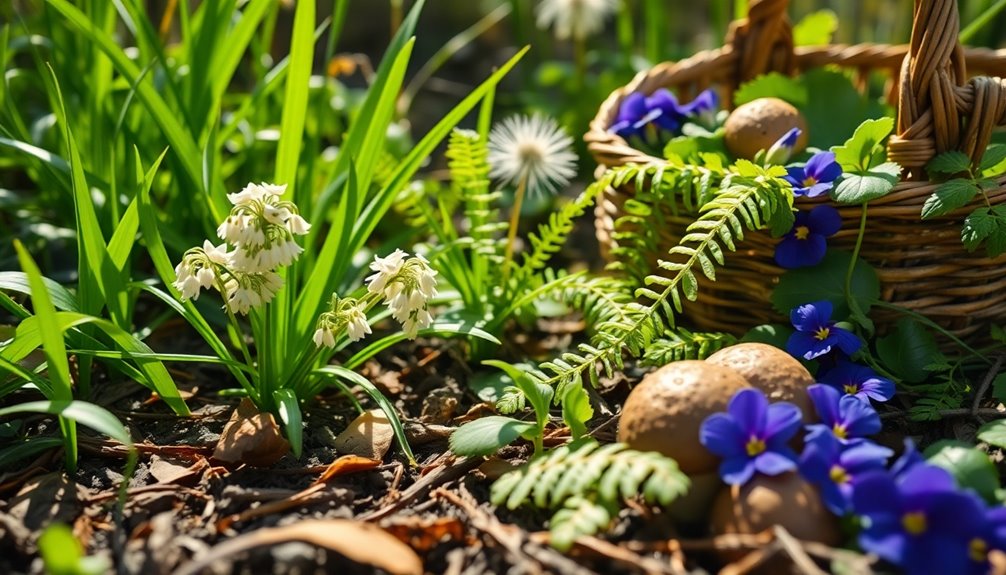
Sustainable foraging practices are essential for preserving the delicate balance of our ecosystems. When you venture into nature to collect wild plants, remember to harvest responsibly. Here are some key points to reflect on:
- Only take what you need, leaving enough for wildlife and future growth.
- Always identify plants accurately, being cautious of toxic look-alikes.
- Engage in community foraging to share knowledge and protect local biodiversity.
By adopting a "leave no trace" approach, you minimize your environmental impact. This means not damaging the surrounding ecosystem and guaranteeing you don't take more than 10% of any single plant population.
Seasonal foraging also helps support local biodiversity while reducing your carbon footprint, as you're consuming what's available in your area instead of relying on imported foods.
Participating in community foraging events is a great way to enhance your understanding of local ecosystems and promote collective responsibility. Together, you can enjoy the benefits of wild food while protecting the delicate balance of nature.
Culinary Uses and Recipes

May brings a bounty of wild flavors just waiting to be explored in your kitchen. You can transform these foraged ingredients into delightful dishes that celebrate the season. Incorporating chia seeds into your recipes can further boost their nutritional value, as they are rich in dietary fiber which promotes gut health.
| Ingredient | Culinary Use | Recipe Idea |
|---|---|---|
| Wild Garlic | Pesto, quiche, salads | Blend with nuts and oil for a crisp pesto. |
| Young Beech Leaves | Infuse gin, make sorbets | Steep in gin for a unique liqueur flavor. |
| St. George's Mushrooms | Sautéed or in pasta dishes | Sauté with olive oil and garlic, serve over pasta. |
| Sea Beet | Salads or cooked like spinach | Toss in salads or sauté with lemon and garlic. |
| Elderflower Blossoms | Syrups or cordials | Create a revitalizing elderflower cordial. |
These flowers can be eaten and add a touch of elegance to your meals. Use wild garlic for its rich flavor, young beech leaves as a versatile plant in various dishes, and St. George's mushrooms to enhance your culinary repertoire. With sea beet and elderflower blossoms, you're set for a month of delicious discoveries!
Community and Foraging Resources

Foraging can be an enriching experience, especially when you tap into the wealth of community resources available. Connecting with others who share your passion for edible plants not only enhances your knowledge but also fosters a sense of belonging.
Here are some valuable resources to explore:
- Community foraging events: Join local groups that organize outings in parks and green spaces to discover seasonal wild foods together.
- Online platforms: Websites like wildfoodie.co.uk and foraging.co.uk allow you to share your experiences, learn from others, and engage with a wider community focused on sustainable practices.
- Educational resources: Check out "The Foragers Calendar" or whisperingearth.co.uk for insights into local edible plants and responsible harvesting techniques.
Organizations like the Woodland Trust emphasize the importance of understanding local ecosystems.
By participating in foraging education, you can guarantee that your practices are sustainable and respectful of nature.
Plus, social media is a fantastic space to share your finds and inspire fellow foragers.
Embrace these community resources to deepen your foraging journey and enjoy the delicious rewards of nature's bounty!
Frequently Asked Questions
What Is the Easiest Food to Forage?
The easiest food to forage is often chickweed. Its mild flavor and high water content make it a great addition to salads or pestos. You'll find it in gardens and grassy areas, so keep an eye out.
Another easy option is dandelions; their young leaves are perfect for salads. With their abundance in many places, you'll have no trouble spotting them.
Just remember, always forage responsibly and guarantee you're confident in your identifications.
What Is the Number One Rule of Foraging?
Did you know that nearly 70% of wild plants have edible counterparts that look similar? The number one rule of foraging is to positively identify any plant before consuming it.
You can't just rely on instinct; using multiple reliable sources like field guides is essential. Always be aware of seasonal variations and respect local laws.
What Is the Best Time to Forage?
The best time to forage is during the cooler hours of early morning or late afternoon.
You'll avoid the heat, which can wilt plants and make them less enjoyable to gather. Plus, these times often provide better visibility and freshness.
Keep an eye on local weather conditions, too, as they can influence what's available.
Stay informed about your region's flora to maximize your foraging experience and discover the best seasonal offerings.
What Should You Avoid When Foraging?
When foraging, you should avoid consuming any plants you can't positively identify, as look-alikes can be toxic.
Steer clear of areas treated with pesticides or chemicals, as these can contaminate the plants.
Be cautious with mushrooms; many edible types have dangerous counterparts.
Don't harvest endangered species to protect local ecosystems, and stay away from roadsides or polluted areas, since plants may absorb harmful pollutants.
Always prioritize safety while enjoying your foraging adventures!
Conclusion
As you step into May's embrace, let the wild edibles be your compass, guiding you to nature's hidden treasures. Each leaf and berry symbolizes the abundance waiting to be discovered, reminding you of the simple joys in life. By practicing sustainable foraging, you not only nourish your body but also honor the earth. So grab your basket, explore the world around you, and savor the fresh delights that nature offers, turning every outing into a culinary adventure.


